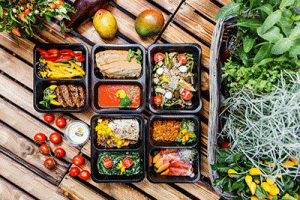Meal Kits | Fast And Delicious
Meal kit delivery services burst on the American market in 2012, with the first offerings from Blue Apron. Hello Fresh, and Plated. The meal kits became a trend, and today there are more than 150 meal kit delivery services.
The idea actually originated in Sweden and spread through Europe. Canada followed America and now offers meal kit delivery.
Nearly one-third of people in the United States claim to have tried a meal kit, and the industry is valued in the billions of dollars. The popularity of meal kit delivery services may be a backlash against fast food. They tend to appeal to affluent males at this time, but clearly, there is an effort to reach the person who regularly provides meals for an entire family.
 What are Meal Kits?
What are Meal Kits?
A meal kit contains all the ingredients to make a home-cooked meal. Typically, these kits include a protein and one or two side items. The food is pre-portioned, and all of the spices and oils are included. Meal kit delivery services include a recipe card with each meal, giving cooking instructions.
Many meal kit companies have chefs on staff and attempt to provide nutritionally balanced meals. The focus is on providing quality food that can be prepared at home in approximately 30 minutes. Customers seem to see this as the antidote to depending on junk food and takeout.
Some meal kit delivery services specialize in certain types of foods, while others aim to appeal to the tastes of the general public.
Types of Food Delivered With Meal Kits
The most common meal kits include a meat or offer seafood as the main course. Vegetables and breads typically accompany these. In short, most meal kit delivery services are built on the idea of the standard American diet.
However, the industry has become associated with healthy eating, so some companies boast various health benefits of their meals.
For example, a few companies offer gluten-free foods or those that are part of a Paleo diet. Others are associated with fitness programs, and offer foods to help people slim down and tone up.
Still, others feature low-carb entrees and sides, as well as low-sugar, and hormone-free foods.
Meal kit delivery services may specialize in foods that are organic foods that are non-GMO. At least one company offers smoothies that meet these criteria and that contain so-called superfoods, such as goji berries and kumquats.
Organic meal kit delivery has become popular, and the companies that feature organic vegetables screen their suppliers to make sure the food is truly organic. Some companies advertise that their foods are locally sourced, and they buy foods in season to get them fresh.
You can find grass-fed beef, and foods free of gluten, soy, eggs, dairy foods and artificial sweeteners. A number of services offer non-GMO foods. Many offer foods with no preservatives and people with allergies can order meal kits that accommodate their sensitivities.
Vegan and ketogenic diet foods are available, as are foods that come from sustainable farms. Those interested in cage-free eggs and free-range chicken can also find meal kit delivery services.
Meal Kits Vs. Home Grocery Delivery
Meal kits can cost less than buying the ingredients at the grocery store. Some companies claim to save the customer up to $20 per entre.
Dollar-for-dollar comparisons are difficult because meal kits come with pre-measured amounts of spices, seasonings, and oils. It is impossible to buy a half-teaspoon of a spice, or half a cup of vegetables, for example. The costs of stocking up on these types of ingredients far exceed the cost of those included in the meal kits.
The other issue is convenience. Time is money for many people, and the hour or so spent at the grocery store looking for special ingredients may not be worth it to some. Cooking will take around 30 minutes, so adding shopping time to that can add up.
The final consideration in comparing meal kits with groceries is waste. With produce especially, leftover vegetables can spoil quickly. Since it is likely that a person would have to purchase far more produce than needed for a single meal, wasted food can become an issue.
Environmental Impact Of Using Meal Kits
In addition to healthy eating, the meal kit delivery industry has become associated with environmentally friendly practices. Many services use biodegradable and recyclable materials in their packaging. One company uses recycled denim to eliminate Styrofoam, as well as non-toxic gel packs. Some meal kit supply companies have been criticized for using gel packs that cannot be recycled, but it remains to be seen if the majority of companies will switch to non-toxic packs or find some that can be recycled.
Socially Responsible Practices | Meal Kits
Shoppers can find meal kit companies that donate extra meals and leftover food to shelters and farms. Also, some companies have relationships with causes such as reducing climate change and promoting good nutrition, as well as doing business with green companies.
The Bottom Line For Meal Kits
Meal kits have been disrupting the food industry for more than six years, and all indications are that they will continue to do so. At this time, they seem to be a fill-in for the weekly meal plans of people that use them. In other words, with an average of one delivery per week, meal kits have become an additional meal that may offset some of the hurried dinners during the rest of the week. Growth estimates into 2022 suggest the industry will continue to grow into the multi-billions of dollars.
Advertising Disclosure: This post contains affiliate links and at no additional cost to you, Watch the Review will be compensated if you make a purchase after clicking on these links.









 What are Meal Kits?
What are Meal Kits?